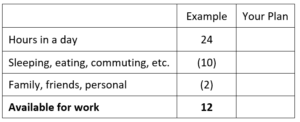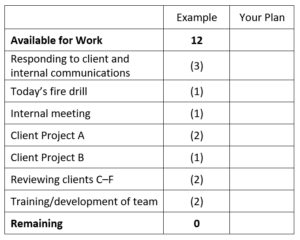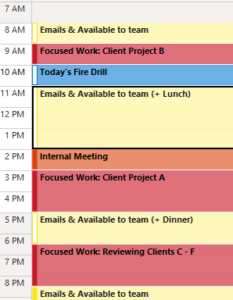How to Prioritize When You’re Overloaded
![]() Kristen Rampe, CPA / Mar 17, 2022
Kristen Rampe, CPA / Mar 17, 2022
The plight of any professional is a continuous status of “busy”. Even when it’s not busy, or not “busy season”, we’re “busy”. In many professional realms busy is a badge of honor; it means you’re good, people want to work with you, and the revenue stream is strong.
not “busy season”, we’re “busy”. In many professional realms busy is a badge of honor; it means you’re good, people want to work with you, and the revenue stream is strong.
Acknowledging that being continuously busy has its drawbacks, accounting professionals will always face busy periods. It’s in those moments that figuring out how to prioritize becomes essential.
Here are five steps to prioritize when you’re overloaded:
1. Get a picture of your available time for work today.
Start with 24 hours, then determine:
-
- How much time you need for sleeping, eating, commuting, exercising, similar hygiene and essential self-care items
- How much time you need for family, friends, and personal
What’s left is your hours available for work.

2. Acknowledge the very real time commitment in responding to client and team communications.
How much time do you spend each day answering emails, replying to chat messages, listening to voicemails and playing phone tag, scheduling meetings? Hint: it’s not zero. Not even close.
Responding to inbound communication takes up real time, even if each task takes only 3 seconds or 3 minutes. The interruption takes a toll, as the mental effort and time it takes to refocus on that client engagement is not insignificant.
You may think thoughtful client engagement work is your top priority, but can you tell me about a time when you didn’t check your email for 4–8 hours because you had 4–8 hours of important client project work to do? It doesn’t happen. Not that it shouldn’t, but we’ve been conditioned to be uber-responsive to internal and external client requests. Of course, clients love us for this – it’s part of the CPA brand. Responsive, available, committed. But could they wait an hour or two? Likely.
Bottom line here: don’t underestimate the amount of time correspondence and communication takes.
How CPA Firms Work: The Business of Public Accounting is a primer that explains how CPA firms work as a business. It is primarily intended for staff that have just joined a firm. We address ►CPA firm economics/how firms make money ►trends in the CPA profession ►what it takes for staff to advance ►the image of CPA firms ►how firms are managed ►how firms get clients ►what attracts staff to CPA firms and other issues.
3. Prioritize your remaining client and internal obligations for today.
-
- Unplanned client emergencies
- Meetings you’re committed to attending
- Specific client engagement work that you need to do because of its complexity
- Reviewing the work of others
- Additional time for in-the-moment training and development of staff. This is real work that facilitates your firm’s leveraged model. Don’t short-change it, because it develops others who can handle more client obligations going forward. And it takes time.
4. Block your time and execute.
Now you’ve laid out how much time you have, what needs to be done, and your priorities. I wish I could tell you the rest is easy, but you know better. Now you need to arrange your day to get done what you’ve decided is most important.
Since you know that checking your emails and being bombarded by chat messages throughout the day lowers your productivity, you may want to block off time, even just an hour at a time, to focus on a specific client engagement. Then get back into your inbox.
Start by using your online calendar to designate open times for taking care of email correspondence and being available to team members who need your help and direction. Perhaps this is in three chunks of time: 8–9 am, 11 am–2 pm and 5–6 pm.
Next, communicate with your team that you’re going to have focused work time today in which you’ll be dedicating your brain to a complex client issue or reviewing a few projects to get them out the door. It might be from 7–8 am, 9–10 am, and 3–5 pm. You’ll be unavailable at this time, but you are available during the times listed earlier.
It may sound scary, but I promise you, your team and your clients can live without you for a couple of hours throughout the day. When these focused work times come, turn off notifications, and keep open only the programs you need to do the task at hand. Resist the temptation to check your messages. They can wait – and if not, rest assured someone will find a way to get through to you.
5. Stay flexible, while honoring your priorities
Yes, the blocks can move around. “Today’s Fire Drill” can be hard to pin down – but you know it’s going to happen. Maybe if it’s still unknown at 10 am, shift up some focused work or email time.
Keep in mind that when you say yes to the next new thing someone asks you to do, you’re saying no to spending your time on something else; at the very least, you’re delaying your ability to get it done.
This is where your prioritization skills show their strength. What new thing deserves to go to the top of the list? What doesn’t, or what can be done by someone else or later?
What are your favorite tools for prioritizing when you’ve got a lot on your plate?

How CPA Firms Work: The Business of Public Accounting
An invaluable resource for new hires that explains how CPA firms work as a business. Use it as part of new employee orientation and onboarding programs to give new employees a solid foundation in the workings of a typical firm.
Learn More
